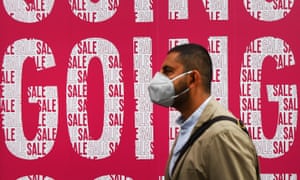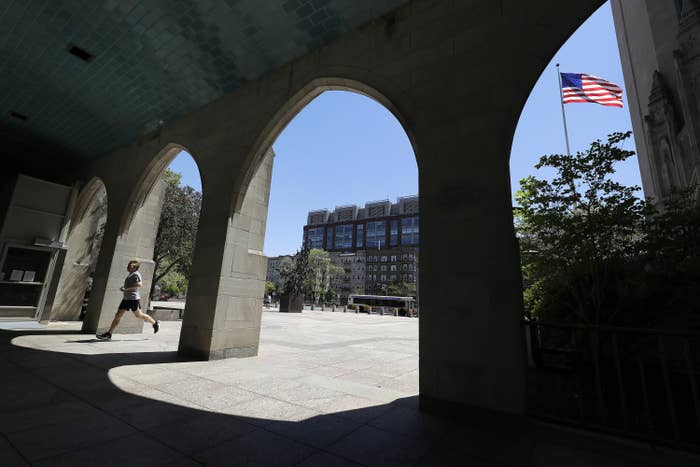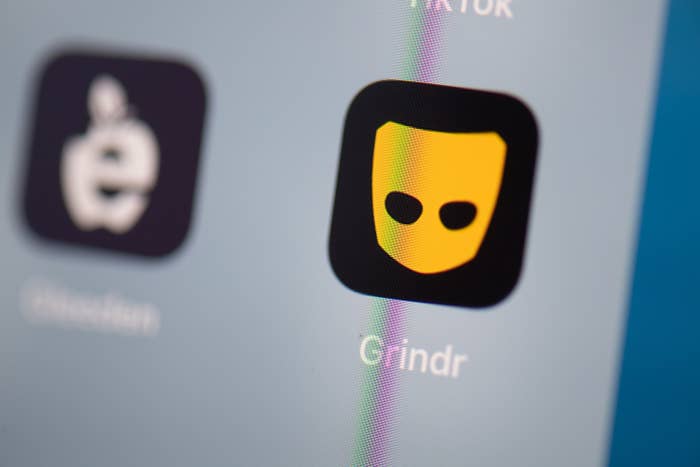Eight-metre statue built in 5th century BC had been buried among ancient ruins
Lorenzo Tondo in Palermo @lorenzo_tondo
Tue 14 Jul 2020

The Atlas statue will soon be raised upright to stand in front of the temple. Photograph: Yuriy Brykaylo/Alamy
A colossal statue of Atlas, buried for centuries among ancient ruins, will soon take its rightful place among the ancient Greek temples of Agrigento on Sicily.
The city’s archaeological park announced that the artwork, one of the most celebrated sculptures on the island, will be raised upright in front of the Temple of Zeus.
In Greek mythology, Atlas was a Titan or god who was forced to bear the sky on his shoulders after being defeated by Zeus, one of the next generation of gods called Olympians.
The statue, eight metres high and built in the 5th century BC, was one of nearly 40 that adorned the ancient building, considered the largest Doric temple ever built, even if it was never completed and now lies in ruins.
“The reinstalment of the statue of Atlas is the culmination of a more comprehensive restoration [of the temple],” says Roberto Sciarratta, director of the archaeological park.
“In the last decade, we’ve recovered and catalogued numerous artefacts that were once a part of the original structure … The goal is to recompose piece-by-piece the trabeation [beams] of the Temple of Zeus to restore a portion of its original splendour.”
A view of Agrigento’s Valley of the Temples. Photograph: Murdo MacLeod/The Guardian
Archaeologists and architects will soon start work to raise the statue in Sicily’s Valley of the Temples on the occasion of the founding of the ancient city of Akragas (now Agrigento) 2,600 years ago.
It was one of the leading population centres in the region during the golden age of Ancient Greece and holds seven well-preserved Greek temples.
Built on a high ridge over a span of 100 years, they remain among the most magnificent examples of Greek architecture. In the 5th century, more than 100,000 people lived there and, according to the philosopher Empedocles, they would “party as if they’ll die tomorrow, and build as if they will live for ever”.
The city was destroyed in 406 BC by the Carthaginians, and its prosperity did not return until the rise of Timoleon in the late third century BC. During the Punic wars, the Carthaginians defended the settlement against the Romans, who seized control of the city in 210 BC.
During the Roman era, the city – renamed Agrigentum (subsequently known as Girgenti) – underwent a period of monumental urban redevelopment with new public buildings, including at least two temples.
Over the centuries, brickwork from the old monuments of the ancient city was taken for use in the construction of the buildings around Girgenti and the ancient harbour of Porto Empedocle.
Historians also maintained that the Temple of Zeus was never finished because it was still lacking a roof when Akragas was conquered by the Carthaginians.
Outside the temple, huge statues of Atlas were frozen in the act of supporting the temple.
“The idea is to reposition one of these Atlases in front of the temple,” says Sciarratta, “so that it may serve as a guardian of the structure dedicated to the father of the gods.”
A colossal statue of Atlas, buried for centuries among ancient ruins, will soon take its rightful place among the ancient Greek temples of Agrigento on Sicily.
The city’s archaeological park announced that the artwork, one of the most celebrated sculptures on the island, will be raised upright in front of the Temple of Zeus.
In Greek mythology, Atlas was a Titan or god who was forced to bear the sky on his shoulders after being defeated by Zeus, one of the next generation of gods called Olympians.
The statue, eight metres high and built in the 5th century BC, was one of nearly 40 that adorned the ancient building, considered the largest Doric temple ever built, even if it was never completed and now lies in ruins.
“The reinstalment of the statue of Atlas is the culmination of a more comprehensive restoration [of the temple],” says Roberto Sciarratta, director of the archaeological park.
“In the last decade, we’ve recovered and catalogued numerous artefacts that were once a part of the original structure … The goal is to recompose piece-by-piece the trabeation [beams] of the Temple of Zeus to restore a portion of its original splendour.”

A view of Agrigento’s Valley of the Temples. Photograph: Murdo MacLeod/The Guardian
Archaeologists and architects will soon start work to raise the statue in Sicily’s Valley of the Temples on the occasion of the founding of the ancient city of Akragas (now Agrigento) 2,600 years ago.
It was one of the leading population centres in the region during the golden age of Ancient Greece and holds seven well-preserved Greek temples.
Built on a high ridge over a span of 100 years, they remain among the most magnificent examples of Greek architecture. In the 5th century, more than 100,000 people lived there and, according to the philosopher Empedocles, they would “party as if they’ll die tomorrow, and build as if they will live for ever”.
The city was destroyed in 406 BC by the Carthaginians, and its prosperity did not return until the rise of Timoleon in the late third century BC. During the Punic wars, the Carthaginians defended the settlement against the Romans, who seized control of the city in 210 BC.
During the Roman era, the city – renamed Agrigentum (subsequently known as Girgenti) – underwent a period of monumental urban redevelopment with new public buildings, including at least two temples.
Over the centuries, brickwork from the old monuments of the ancient city was taken for use in the construction of the buildings around Girgenti and the ancient harbour of Porto Empedocle.
Historians also maintained that the Temple of Zeus was never finished because it was still lacking a roof when Akragas was conquered by the Carthaginians.
Outside the temple, huge statues of Atlas were frozen in the act of supporting the temple.
“The idea is to reposition one of these Atlases in front of the temple,” says Sciarratta, “so that it may serve as a guardian of the structure dedicated to the father of the gods.”




















